July 28th, 2013
By Eric Blumberg

Eric Blumberg is an award-winning radio talk show host who also has gained acclaim as a reporter and columnist for several radio stations and local weekly newspapers. Born in New York City in 1952, he received his B.A, in Media Studies at Hunter College and spent two years at the graduate school of journalism at the University of Texas in Austin. He spent the majority of his broadcast journalism career in Austin, where he was recognized four times as the city’s best radio talk show host. Blumberg has taught journalism at Austin Community College as well as English as a second language and writing at Western Iowa Tech Community College in Sioux City. He now lives in Sioux City, Iowa with his wife, Cindy Waitt. He has three daughters and one stepson.
To U.S. Residents Living Outside Iowa’s Fourth Congressional District:
As a resident of Sioux City, Iowa and a member of the city’s Human Rights Commission, I want to offer all of you my sincerest apologies for the continued stupidity of my U.S. Congressman, Steve King.
His most recent hateful comments regarding those who would benefit from the Immigration Reform Bill are not necessarily those of his constituents. Nonetheless, you might get the impression that those Iowans of King’s 5th district are mindless bigots in the fashion of our Congressman.
Iowans are fair people, who, by and large, do not condemn other people simply based on their race, gender, sexual orientation, religion or, in this case, their current immigration status.
While I do understand what the Congressman is trying to say, I don’t understand why he chose to say it in the fashion he did.
Subsequent to his initial remarks from this July, he took the floor of the Congress to explain himself more thoroughly. In that statement, he, once again, alluded to his belief that the overwhelming majority of those minors who would receive a path to U.S. citizenship are working for Mexican drug cartels in an effort to supply us with the illegal substances we crave.
King stood by his statement that for each valedictorian there are 100 drug mules, adding that there cannot be any doubt of his beliefs since they are backed by logic and scientifically empirical data.
To me, that means that for every 101 undocumented teens living in the U.S., 100 are criminals. I find that hard to believe. However, if this is so, I want statistical proof. Not a guess or an assumption based on personal opinion, but mathematical certainty based on numbers derived from a credible source rather than out of his ass.
I’m well aware the 5th District voters spoke in 2012 and re-elected him by another large margin, however, that doesn’t mean we can’t speak up when faced with unrelenting ignorance and idiocy.
I’m also aware there is no recourse here in Iowa to recall King and am also aware he is too stupid to realize how wrong he is. Thus, you will never receive an apology from him.
The best we can do here in Iowa’s 4th District is to apologize for him and trust the rest of the country does not look too harshly on us since we are not bigots, but simply a group of inherently good people represented by one.
Comments (2)
June 19th, 2013

The 2010 Workplace Bullying Survey, courtesy Workplace Bullying Institute
“I think adults need to know they’re doing the same thing. It’s not just kids. There are adults that are out there bullying, and they need to be kind.” Ellen DeGeneres
As a supporter of school bullying prevention programs for almost 15 years, I am encouraged. More and more states have passed anti bullying laws, more school systems have begun implementing programs, the reception of the documentary “Bully” has been overwhelming, and we’ve finally collectively decided that the “kids will be kids” excuse isn’t working anymore. As thirty percent of students in the United States are involved in bullying on a regular basis either as a victim, bully or both and over 13 million kids are suffering from bullying, the movement needed to happen, and it needs to continue. Thankfully, as the “Bully” team went through the process of making the documentary, we found fierce advocates. They came from everywhere. Kids, parents, teachers, the media, celebrities, and Congress on both sides of the aisle stepped up and spoke out.
But, where are we when the mirror turns to us big kids? I’ve found less support there, and it doesn’t surprise me. It’s harder to turn the spotlight on ourselves. A Huffington Post piece I did in October, 2012, called “Who Did You Bully today?” http://www.huffingtonpost.com/cindy-waitt/who-did-you-bully-today_b_2006802.html, made the point that until we stopped bullying each other, we won’t see the results we want to see from our kids. I named multiple sectors of adults (including me) who bully, from the home (the first role models kids have, and the most important place to stem violence), to the workplace, to Congress, to cyberspace, and yes, the constant, mind numbing barrage of reality shows. A lot of these big boys and big girls in all of these places continue to not only not be kind, but to be brutal to each other on so many of our adult “playgrounds and school yards”. I’ve written about the link between violence in the home and violence in school, and the data backs it up. But, as the workplace, for us, is similar to our schoolyard, where we interact, socialize, work, play, learn, grow, and spend much of our waking hours, I decided to check into that again and see just how we are doing.
It’s not good. As you can see above, 35% report being bullied at some time in their work life, and another 15% witnessed it. Putting the numbers together, WBI says, with a well place exclamation point, “An astonishing 54 million Americans directly experience it!”. I get the exclamation. That’s abysmal news. The Waitt Institute for Violence Prevention actually co-sponsored the first national survey with WBI and Zogby in 2007, and those results were similar, and disheartening.
“Bully” explores the mental, physical, and emotional toll on the victims and their families. It’s hard to watch Alex being brutalized, and the despair of the Longs and the Smalleys, who suffered the cruelest loss-the suicide of their children. We don’t have a film like that to show damage from the workplace, but it’s there. The late Tim Field, an early advocate of workplace bullying prevention, said, ” Nothing can prepare you for living or working with a sociopathic serial bully. It is the most devastating, draining, misunderstood, and ultimately futile experience imaginable.”.
Here’s a slice of what it looks like, according to WBI. Is this happening to you, or someone in your workplace?
- Verbal abuse
- Offensive conduct/behaviors (including nonverbal) which are threatening, humiliating, or intimidating
- Work interference — sabotage — which prevents work from getting done
- Is driven by perpetrators’ need to control the targeted individual(s).
- Is initiated by bullies who choose their targets, timing, location, and methods.
- Requires consequences for the targeted individual
- Escalates to involve others who side with the bully, either voluntarily or through coercion.
- Undermines legitimate business interests when bullies’ personal agendas take precedence over work itself.
- Is akin to domestic violence at work, where the abuser is on the payroll
- Constant criticism
- Mobbing or targeting by a group
It’s classic bullying, and looking at the list, eerily similar to what can happen to children. The outcome looks similar to what children experience as well. Here are the consequences to our bodies and our minds according to a WBI online survey in 2012. “The top 15 health problems from bullying, ranked from most to least frequent, were:Anticipation of next negative event; Overwhelming anxiety; Sleep disruption (hard to begin/too little); Loss of concentration or memory; Uncontrollable mood swings; States of agitation or anger; Pervasive sadness; Heart palpitations; Insomnia; High blood pressure (hypertension); Obsession over personal circumstances; Intrusive thoughts (flashbacks, nightmares); Loss of affect (flat emotional responses); Depression (diagnosed); Migraine headaches”
It’s real, it’s pervasive, and all of it needs attention, just as we’ve started attending to our kids. I have hopes that the current school age generation may learn early what we adults haven’t. I also have hopes that because of the anti school bullying and violence prevention movement, we can give today’s children the social and emotional tools to recognize bullying in themselves and in others. But, if we continue to treat each other this way, wherever we interact as grown ups, can we continue then to expect more from our kids? Let’s learn to model respect, kindness, and decency. Kids watch us, they listen to us, and we can make a difference. But, let’s look in the mirror first, and go from there .
For more information, visit these sites….
Comments (0)
June 9th, 2013
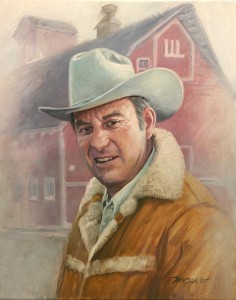
Painting of my father by Mick McGinty
“Inside a barn is a whole universe, with its own time zone and climate and ecosystem, a shadowy world of swirling dust illuminated in tiger stripes by light shining through the cracks in the boards.” Carolyn Jourdan
My brothers’ company, “Gateway 2000”, later to become just “Gateway” didn’t start in a barn, as they loved to say in those days… a lot. It started in September of 1985 in a small farmhouse on the land where that barn stood. Regardless, those young men saw it every day. A early, famous ad “Computers from Iowa?” showed that barn and my brothers, and I’d guess that’s why the phone started ringing. It was real, it was unique in those days of the early Silicon Valley companies, and it was my father’s land, and my father’s barn. With that and the cattle that land once had, a brand was built. It was a big barn, and what it stood for became a big brand, at least for a time.

Ted and his talking cow
The barn meant a lot to my father who purchased the land in the 70’s, as did the land. My father’s relationship with the land was interesting, for a white man of his time. He told me that it wasn’t something he just owned, it was simply his job to take care of it while he was here. Strangely, my brother, Ted, said something like that just two weeks ago. It was Native American land once, taken from them by someone, as it sadly happened when the white men showed up here in this corner of Northwest Iowa. The land had had a few owners by the time my father had it, I don’t know all of the history and I don’t know what year the barn was built. But it was an impressive barn, big and dark red and always beautifully maintained by my father. It almost took your breath away when you went up over the hill and saw it for the first time.

My son Ben and niece Stephanie, early 90's.
My father’s family had a long history in the Loess Hills of Iowa. The first ancestors, William Palmer Holman and his wife Lois Grant Holman, father of Ella Waitt, arrived here in 1856. She died 3 months after they arrived. Her letter written home to family in Connecticut speaks of the beauty of the hills and the river, although it was a strange land for her, and she missed the comforts of the east. She was the first white woman buried in this county. http://cindywaitt.com/pilgrims-presidentsand-pioneers-looking-for-lois/ Four generations of Waitt brothers followed WP Holman in the cattle business, until my father realized that the business he once knew really didn’t exist in the same way anymore. He advised my brothers to do something else, and they did, but not without a nod to their roots. That nod to Iowa and all those barns and those cow spots as homage to those generations built a brand that one could see in many parts of the world in the 1990’s. I used to love seeing it in downtown New York and London. It said Iowa to me.
So, this past few weeks, as I’m re doing the front page of my website, I had to choose a picture, just one to keep it simple,that might speak for what I do, and what I am. I looked for something that told my story, about me, my family, my work, and how I see things. After looking at probably hundreds of pictures of my life, my work, and my family, here’s what I landed on, and that’s why I’m writing this piece.

The barn and land, over 20 years ago. The land's a golf course now, but the barn is still there.
It’s a bit blurry, as is my memory of it in those days. I’ve asked my friend Thomas, who does my changes, to make it that way. It seemed right. The barn does stand for what I’m about, I think. A peaceful setting, nature, family, and roots. Barns like that barn and the fertile land they stood on were and still are the lifeblood of Iowa, though it’s changing these days. That way of life fed a lot of families, including mine. The company that started right next to that barn made the money that we can all give back to others today. Both the land and the company are owned by others now. But the barn still stands, and to me the picture said, in 1,000 ways, this is home.
Comments (4)
May 30th, 2013

July 2, 2011,one gloriously happy day among many
My husband came out before I did, and he did it publicly. It was 2005. He was living in Austin, Texas then and was approached by the Austin American Statesman to be a part of stories of Austin celebrities who’d struggled with mental illness. He was by joined singer Shawn Colvin, former NFL player Hollywood Henderson, and a former Lieutenant Governor. Eric was well known at that time for his years as an award winning radio talk show host there, and he was used to speaking his mind. He’d never spoken about it on the radio. He’d left the business and was working in the mental health field himself by then. In the story, he spoke about being diagnosed with depression in his early 20’s and then bipolar disorder in his early 30’s, and he was glad he did. He’d been well for many years. He’s well now.
Eric tends to be gutsier about things like that. I worry too much about what everyone might think. I always have. It took me years to discuss my early bout with post partum depression and my later battle with a perfect anxiety storm several years ago. My rounds with illness are few and far between, but when they come, they’re pretty harsh. http://cindywaitt.com/the-mean-reds/ . Happily, I’m well now too.
I call it “coming out” because it is. There’s a great big mental health closet in this country, and it’s bursting at the seams. An estimated 26.2 percent of Americans ages 18 and older — about one in four adults — suffer from a diagnosable mental disorder in a given year. That’s over 50 million of us. We either need a bigger closet or more people to step out of it. I get why they don’t. It’s not because they aren’t brave. They are. It takes guts to live with mental health issues. They don’t because it’s rare to find someone who gets what they have.
When I heard about the plot of the much lauded Silver Linings Playbook , based on the novel by Matthew Quick, that looks at the relationship of a young man struggling with bipolar disorder and a young woman who is recovering from tragedy, struggles with relationships, and has a big dose of anxiety on top of it, I had to see it. It was, in a strange way, our story. And, as good issue films can often do, it started a conversation.
One friend told me it hit too close to home. Another friend stated pretty clearly that although the film had a happy ending, she was frankly worried about the young couple dealing with not only one mental illness, but two. She had a point. Relationships are hard and relationships where one partner struggles with mental illness are most likely harder. But what if they both have one, like the characters played by Bradley Cooper and Jennifer Lawrence do, and like my husband and I do? I wasn’t as worried for them. When I see happy Hollywood endings, I know there’s more to come, (someone once said that the next scene after the credits roll is usually about the fight over who’s taking out the garbage…) but I felt that this couple would make it, maybe because… we did.
I’ve known my husband for 12 years, and have been with him for four years. We reconnected when I was fairly newly home from treatment for anxiety in 2009. Our first conversation was about that, and that’s when he told me about his own battles with what Winston Churchill called “The Black Dog”. I knew vaguely that he’d had depression, but I didn’t know the extent of what he’d gone through. I heard the whole frightening story in that first conversation. Here’s what he’s said about it, not only to me, but publicly. He first became ill in the early college years at Beloit. Then it hit. After a horrifying stay in the hospital, and multiple types of treatments, he says, “I was then able to recoup my sanity, work six years in a neighborhood butcher shop in Manhattan and resume my college career, which included graduating Summa Cum Laude at Hunter College and acceptance into the graduate school of journalism at the University of Texas.” A home run there, I’d say.
He goes on to talk about when it came back in his early thirties. “It was during those years in Austin that my true diagnosis became apparent when I was stricken with a ferocious onset of mania after which I was hospitalized and given my true cross to bear, bipolar disorder. It was a cross I did indeed bear well as I was able to become a successful journalist, radio talk show host and ultimately a certified peer specialist whose charge it was to assist others living with a mental illness in coming to grips with their own so-called demons.” Knocked it out of the park again.
For a guy with that harsh an illness, he’d hit a whole bunch of home runs and it seemed he was most likely home free. But still, it gave me pause. The Eric I knew was a calm and centered guy, seemingly a perfect foil for my buzzy anxiety driven moods. And he was. But what if HE got sick again’? It hadn’t happened for close to 30 years so there was no indication that it would, but still, I worried. Not excessively as people with anxiety disorders like me do, if they’re not managing it right, but I did worry sometimes. I’d gotten so much stronger, and I was proud of my recovery, and I knew I couldn’t let anything put that or me at risk.
We moved on to courtship and romance, and all that fun stuff. We were married in 2011. I was in the best, healthiest, and most important, the happiest relationship of my life. We could play like kids, but we were both grown ups. Then he got sick.
It was Valentine’s Day 2012. We were still newlyweds. I knew he’d been feeling off, and had had a slight medication change, but he just hadn’t been 100% Eric. But… he was functional. I was looking forward to a planned night out to dinner and his usual roses and card and all the little wonders he’d do on special occasions. What I got was a call from his department head at the community college where he taught. She wanted to know if he’d gotten home all right, as she thought he might be having symptoms of a heart attack. It wasn’t his heart, we made sure of that. It was his brain. It had stopped functioning the way you need to function when you want to go through life and go through it well. If you’ve ever seen someone you love like that, you’ll know what I’m talking about. It’s quite simply…terrifying. A “brain illness” (that’s what we call it) is particularly excruciating, not only for the person suffering through it, but for those who love them. You don’t know when it will end, and as psychiatry is still somewhat “trial and error”, you don’t really know IF it will end.
It ended and it ended well. We got through it. Strangely, as Eric got worse, though, I got stronger. Someone had to be. He’d done it for me as I was recovering and had been there, as my family had. My turn, then. Gradually, after a few one step forward, two steps back dance, he pulled out of it. The meds that had stopped working for him were changed and they landed on the right “cocktail”. He went back to therapy. And one spring day, he was almost suddenly after several months, my Eric again.
I’m not sure if we have an actual “playbook” to manage what we manage. “My Eric” is now the calm, centered, funny, thoughtful, and brilliant man I fell in love with. But the struggling Eric was “My Eric” too. The “In sickness and in health” clause we’d agreed to in June of 2011 was tested earlier than I’d thought it would be. But we got through it. We are actually better than ever right now. We were tested. We passed. And, if it comes back again, to either of us, we’ll pass that time too.
I’ve heard this line before. I don’t know when, but I always liked it. “The world breaks everyone, and some are strong in the broken places”. We didn’t break and I hope this story, as hard as it was for me to tell, can help just one of the millions who has or has ever had a dark time, or loves someone who has a dark time. It IS dark, it is scary, and it is cloudy, but sometimes, at the end of that, there is a silver lining.
Comments (6)
May 20th, 2013

From Leslie Morgan Steiner’s book”Crazy Love”
Updated October 12, 2014
“Kit, it might be good if you’d provide a statistic. I’m no expert, but it’s my understanding that domestic violence only affects poor, uneducated people. Lawyers, doctors, and professors do not beat their wives and children.” Sociology professor to Kit Gruelle
One of the scenes I found most compelling when I was looking at footage a couple of years ago for the upcoming HBO documentary “Private Violence” is the one above. My friend, colleague, and narrator, subject and special adviser to the film, reads this from her sociology professor in a scene we hope will challenge one of the age old myths of domestic violence- that it doesn’t happen to people who grew up like me.
I was raised in a family of privilege in the 1950’s, 60’s, and early 70’s in a small city in Iowa. We had a lovely home with a swimming pool, in a pretty neighborhood. My father owned his family cattle business, my mother was a community volunteer and a member of the Junior League. My parents’ friends were CEO’s, doctors, lawyers, and “pillars of the community”. We had great vacations, summer camp, and college educations provided. We spent much of our time at the Country Club, playing with the children of those pillars of the community.
I don’t think I’d ever heard much about family violence. I’d never seen it in my home, because there wasn’t any. I don’t remember any friends who ever spoke of it. It just wasn’t discussed. As Gloria Steinem says frequently, “there was no word for domestic violence, it was just called “life”. It wasn’t a life I knew.
The first time I heard from a victim of this secret subject was when I was in my first year of college. The story was from an older woman, I’ve just called her “Emma” when I’ve told her story.
Emma was a neighbor, a woman of wealth and position, a college graduate with a lovely home, a grandmother. Emma was the May Queen at her University, where she graduated in 1922. She was knocked down by her husband in the hallway in that lovely home in the 60’s, and hospitalized with a broken back. The man wasn’t her first husband, they had no children together, and she was fortunate as she had means, owned the home, and was able to get him out of the home with the help of family. So many women aren’t that fortunate. He was never charged with anything. Few men like him were in those days.
I was stunned by her story, and was certain that this was a rare case, particularly among people like that… like us. My social work education and career opened my eyes to the scourge of family violence, the victims, the perpetrators and the kids permanently scarred who witnessed it. Perhaps this fueled my later support of violence prevention. Or perhaps it was for Emma, who had her back broken.
One of the myths of domestic violence is that there is what my friend, colleague, and long time domestic violence victim’s advocate Kit Gruelle , receiver of the rather stunning note above, calls “the typical victim”. She scoffs at that phrase. To her the “typical victim” isn’t typical, and whatever the unenlightened think it is, as she says musically, “it ain’t that”. And, it isn’t.
We still too often see “that” victim as poor, struggling, and uneducated, as did her professor, when she was completing a degree in social work. The note wasn’t written in the 1960’s. It was a couple of years ago. And though Kit says today that many of her teachers were absolutely amazing and well versed in domestic violence, this one, a PhD in Sociology, wasn’t.
When we began gathering stories for a history project of just a few of the millions of victims of domestic abuse, Kit wanted to make sure we had footage of women who’ve experienced abuse who didn’t fit “the profile”. She knew of many. She can leave the names off and tell you their stories. She found one during the filming, who not only told us her story, but told readers of story in her book “Crazy Love”, told countless interviewers, and recently told close to a million people via a TED talk. Her name is Leslie Morgan Steiner and her talk, viewed over 2,000,000 times is here. http://www.ted.com/talks/leslie_morgan_steiner_why_domestic_violence_victims_don_t_leave.html. It’s powerful, it’s honest, and it’s worth watching.
Leslie, in 2009 to CNN, summarized the attitudes some of us still have of families with power, stature, wealth, or celebrity. It was shortly after after the highly publicized story of the assault of Rihanna by Chris Brown, “ Like Rihanna, I had a bright future in my early 20s. I met my abusive lover at 22. I’d just graduated from Harvard and had a job at Seventeen Magazine in New York. My husband worked on Wall Street and was an Ivy League graduate as well. In our world, we were the last couple you’d imagine enmeshed in domestic violence.”
She’s right. We wrap a bubble around those of status, fortune, fame and privilege. We have footage from years ago of Senator Patrick Leahy, a longtime sponsor and supporter of the Violence Against Women Act, talking about that bubble. He speaks of people who don’t want to think it happens in the house next door and says, “It DOES happen in your town, it DOES happen in your neighborhood..” And it does.
Dr. Susan Weitzman, who spent years researching what she calls “upscale violence”, and authored the 2000 book “Not to People Like Us: Hidden Abuse in Upscale Marriages” http://drsusanweitzman.com/ has profiles of both victim and perpetrator on her site. She echoes much of what Kit Gruelle has to say about what Dr. Jeanne King calls “Domestic Violence, Tiffany’s Style”. There are specific challenges to this type of case, including societal disbelief, peer pressure to remain silent, and the difficulty of taking on someone with wealth, position, and power. Gruelle says, “Because their husbands are men of position and this guy has a very public persona, it adds another complex layer for the victims. Everyone in the community has their mind made up about this guy.”
As more high profile cases of abuse “Tiffany’s style” keep coming to light, it’s worth remembering that the “typical victim” isn’t so typical any more and perhaps never was. I still go to the Country Club with my mother, and I sometimes look around the jovial and gentile crowd and think about the stories that might always be hidden, that may never be talked about, but stories and experiences surely, for the victims and the families, that won’t be forgotten.
Emma, this one is for you.
Comments (8)
May 15th, 2013
To dearest Norm, with love.
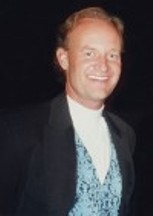
Norm all dressed up for something…
“One man practicing kindness in the wilderness is worth all the temples this world pulls.”
Jack Kerouac, The Dharma Bums
“Every family needs a Norm” Eric Blumberg
Norm is my older brother, but I’m fiercely protective of him. That’s just the way it is. As very small children, he was, according to my mother, very protective of me, so perhaps I’m just paying it back. So, there you have it. If you mess with Norm, you’ll answer to me. 🙂
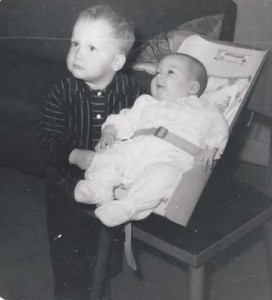
His kindness is almost pristine. His humor is legendary. His generosity is enormous, and much of the time, it’s quiet. His humble ways sometimes fool people, but underestimate him at your own peril, because his mind and his memory are razor sharp. He can be trusting, sometimes to a fault, like I am. He loves music, he loves art, he loves to fly from place to place, (unlike me), he’s way more physically fit than most people, he gathers beautiful things, and he gives beautiful things back. He’s a stellar friend, a great dad, a loving brother, and an irreplaceable human being.
My husband Eric, who as a former journalist, is a pretty decent judge of character, said an interesting thing to me one night after I’d hung up from a conversation with Norm and said something like “Oh, Norm…he’s just so sweet”. He said, “Every family needs a Norm”. They do, and every world needs a Norm too. We’re glad he’s here.
For his birthday, I’m gathering good thoughts from friends, acquaintances, and colleagues to give to him at his birthday dinner this week. Please leave a wish for Norm in the comments and tell him that you’re glad he’s here too. 🙂
Comments (26)
May 2nd, 2013

Must be the 1960’s here…
Back up Maggie Smith, stand aside Shirley MacLaine, watch out Lucille Bluth, we’ve got…Big Joan.
She’s beautiful, she’s brilliant, she loves her children and grand children, and she has a collection of one, two, and three liners that rival the best of them. She’s Joan Gaston Waitt, she’ll be 82 this week, and she’s my mother. In honor of this milestone, I thought I’d share just SOME of the zingers that have escaped from her lovely mouth over the years. To catalog all of them would take years. We’ve thought of saving her e-mails (those are particularly outstanding), but again…would take just too much time. There are so many….
A short bio here- She was born in St. Louis in 1931 to Scott and Zelda Fitzgerald…(oh, I got that wrong), Mildred Emma Armstead and William Matthew Gaston, who were college sweethearts from good old Kansas families. She landed in Sioux City, Iowa after her parents divorce and her mother’s remarriage to a wealthy businessman who owned American PopCorn Company. It was during the the Second World War, shortly after their move, when she proceeded to attract the attention of my father. They were both about thirteen and he never stood a chance. He describes her walking in to their junior high school, in 1944 as having “her nose up in the air.” She says that she was actually shy, as she’d moved many times in her childhood. My parents kept in touch for many years, despite her boarding schools and her years at Northwestern School of Speech and Drama in Evanston, Illinois, and his service in the Air Force, and when he heard that she was engaged to someone else, he made his move. She always said she had three choices at that point. Trying out for the Pasadena Playhouse, teaching English at her private school, or marrying Norm Waitt.
They were married in 1953. Norm Jr. was born in 1954, I came along in 1956, my sister Marcia in 1959, and little Teddy in 1963. She was always a whirlwind of activity, ran our house like a domestic drill sergeant, with the help of a nanny or two, and made sure everything was just right. One of her strengths is organization. It had to be in dealing with four children and probably hundreds of our friends over the years, who liked to hang out at our house and observe the general chaos. My father was a cattleman and traveled a lot. I think in response, she developed a sharp eye for our nonsense, and an even sharper tongue. As she’s gotten older, she has perhaps unknowingly honed that skill to practically an artless kind of art. She doesn’t practice her barbs. That’s the fun part. They are actually unplanned and just roll off the tongue. Sometimes it’s cringe worthy, but most other times, it’s just plain hilarious.
This is a work in progress, as I expect my readers, my family members, and friends who know her, will add some more. Here’s a few…
1) T0 me in 2006 at my 50th birthday party, a lovely formal affair given by my brother. I had friends and colleagues come in from across the country. I had warned them that my mother would insult an article of my clothing within 15 seconds of seeing me. They didn’t believe me, I should have put money up. So, I walk in with a dress I’d had made. I liked it. She wasn’t fond of it. “Well, you look lovely dear, but that’s the ugliest dress I’ve ever seen on you next to your first wedding dress.” Score. Didn’t I tell you people?
2) To my sister Marcia, I have no idea when, must have been at cocktail hour… “The trouble with you is that you don’t drink enough”. Huh?
3) Here’s one of my favorites- mid 1990’s. A group of my friends and my son were assembled at my house, ready to go to our yearly big music festival we call “Saturday in The Park”. You have to know that my mother generally does the white glove test when she arrives at your house, not only with the decor, and the general condition of the home, but to who ever happens to be in that home at that time. So, being Joan, here’s what she said, “Ben, sit up straight, you’re slouching, Reba, get rid of that dog, Robbie, you’re too dressed up for the park, you should look more grubby today, like my daughter looks…. My son Ben said then, “Grandma you forgot Jeremy”. She calmly told him “I’ll get to Jeremy later”. A year or so passed, and she ran into Jeremy. The first thing out of her mouth was “Jeremy, you look awful, get rid of that beard, for God’s sake.” Mind like a steel trap. Never forgets anything. I’m not making this up, ask him (Jeremy Pigg/Facebook)…go on, ask him..
UPDATE: Jeremy just weighed in, here’s his slight correction of the run in….
It's Spring in Sioux City circa 1999. Joan and Norm have arrived back in Sioux after wintering in a warmer locale. She bursts into the Bell, Book,and Candle
with a purse,a travel bag and a small dog (maybe two small dogs - memory fails me here). She drops the luggage, releases the hound(s)? and I know in my heart
that she nailed Cindy or Robbie with a classic comment. I come downstairs from the loft office that overlooked the bookstore and greeted Joan. She "clasped"
with a sharp smack both of my cheeks and says, "Jeremy, it's so nice to see you again... You need to shave. Only ugly people wear beards."
About an hour later Cindy says to me... "So my mother must think you're good-looking." Me: "What? She said I was ugly." Cindy: "NO- she said UGLY people WEAR
beards and YOU should SHAVE."
4) I was married in 2011 to Eric Blumberg. Eric is a former radio talk show host and teaches community college, neither of which made him a wealthy man. She actually likes Eric, because being a New Yorker, he occasionally tells her to “pipe down”. Yes, he says that. So, when I let her know we’d be getting married, she said, “Leave it to you to marry the only Jewish man I know with no money”. Bam. He thought that one was pretty good.
5) We’ll start on my brother Ted here, a frequent target. She didn’t care that her two sons achieved considerable fortune and a little bit of fame. They were just Normie and Teddy to her. We were sitting in the waiting room of one of her doctors, absolutely full of people, who knew who we were. There was a rumor in our local newspaper that Ted might purchase some big sports franchise, I think it was the Minnesota Vikings. She looked at it in disgust and said, quite clearly, “If your brother doesn’t quit spending his money, he won’t be able to buy the Sioux City Bandits”. Heads turn, I shrink down in my seat.
6) It gets better. Ted again. I think it was 2003, and he was about to travel to South Africa with the Clintons. She looked at him sternly and said, “You tell that Bill Clinton you have four children and a company to run, and you don’t have time to run around the damn world with him”. I then said to her, “Mom, maybe if we see President Clinton, you can tell him that”. “Oh, I will” she added. We are still waiting breathlessly for that meeting. I will keep you posted.
7) My siblings and I have had a few weddings between us. 11, actually. There were three that have taken place since my father passed in 2003. A woman who was married 50 years to the same man, she has flatly stated that she will attend no more weddings. “Your father is rolling over in his grave at all these weddings. I’m rolling over in my grave and I’m not even dead yet”
8) This one was fun. Do remember this. Her lines are generally a bit public, sometimes said in a stage whisper. I can’t even remember the incident, but Ted had done something that annoyed her. Most likely to keep his head from getting too darned big, she has to keep him in line and she said (stage whisper here), more than once, “I must have dropped him on his head”.
9) One more Ted line. My brother was well known for his somewhat dodgy adventures in his youth. He’d done something a bit more “adventurous” than usual when he was about 19 and she said, “Your brother will either end up the president of General Motors or in prison”. Whew….glad that didn’t happen.
10) But wait there’s more…..I just can’t think of all of them right now. When I just asked my son to remember some of grandma’s best, he said to me, “oh, mom, there’s too many”….
We always remind ourselves that in truth, that woman would take a bullet for any one of us, and any one of our children. Mercifully, my mother not rolling over in her grave and is still gloriously with us, and hopefully will be entertaining our ever expanding troops for years to come. This is just a starter list. If you know her, feel free to add some more. But don’t tell her or she will get you…and your little dog too. 🙂
Love you, mom, and happy birthday!
Comments (8)
April 16th, 2013
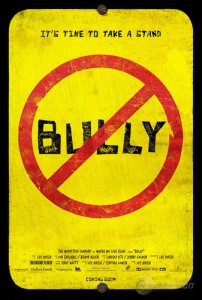
“Bully” 2012. Premiered on PBS Independent Lens, 2014

“Private Violence” premiered October 20th , 2014 on HBO
Updated August 12, 2015
“It was the best of times, it was the worst of times” Charles Dickens, Tale of Two Cities
On September 28th, we’ll be attending the 36th Annual News and Documentary Emmy Awards in honor of two films that we supported from their inception, “Bully” and “Private Violence”.
“Bully” received 2 nominations, one for “Best Documentary” and the other for “Outstanding Informational Programming-Long Form”. “Private Violence” was also nominated in the “Outstanding Informational Programming-Long Form” category.
Last year these two films that are near and dear to our hearts premiered on national television screens, one week apart. As it is was not only “Domestic Violence Awareness Month” and “National Bullying Prevention Month”, there was some symmetry to that. “Bully” opened the PBS Independent Lens season on October 13th, 2014. “Private Violence’ premiered on HBO on October 20th, 2014 As early supporters of both projects, we at Waitt Institute for Violence Prevention couldn’t have been happier about that. But their road to the finish line couldn’t have been be more different.
A national phenomenon, when released in March, 2012, “Bully” had the “buzz’ from the start. It struck a powerful chord, in its riveting and authentic footage of children and families devastated by bullying. Kids tormenting kids hits us at a basic level, and it’s a powerful punch. “Bully’s” path to completion was relatively swift, as enthusiastic funders signed on beginning in late 2009. When it premiered at the Tribeca Film Festival in 2011 to audience and critical praise, ”Bully” was quickly bought by the Weinstein Company, ensuring its theatrical release, and thrusting it into the national consciousness. Lee Hirsch and Cynthia Lowen’s story, that was in its first stages when they found us in 2009, was and is a perfect meshing of the right time, right place, and right issue. The skill and passion of the filmmakers has helped spark a movement no one could have predicted, which is more than a good thing, it’s a great thing.
“Private Violence”, a film we came on board with in 2006, is a very different story. Cynthia Hill’s direction, Kit Gruelle’s voice and vision throughout, and Deanna Walters frightening and extraordinary journey weaves the experiences of domestic abuse survivors and advocates, as it challenges, and consequently explodes the myths behind domestic violence. It finally answers the age old question, “Why doesn’t she just leave’?
While this documentary was driven by the same hopes, concerns, and passions as “Bully”, the supporters and crew of “Private Violence” faced a tougher path to completion. Production and post production of “Bully” took about two years to fund. “Private Violence”, premiering on HBO October 20th, was started over 8 years ago. For all of us at both the Waitt Institute and the Kind World Foundation who backed the film and for all the others who worked to see that film completed, it was a long road.
It happened faster for “Bully” and that didn’t completely surprise me. In my 23 years of philanthropy, I’ve seen children’s issues get funded first. They are the future, and we have to work with them now. It also had never been done. It was desperately needed and it was time.
But we have to see that the first time some children see or witness violence isn’t the school yard. It’s where they live. Approximately 8.2 million children were exposed to family violence in the last year alone.
As early backers of both films, the Waitt Institute for Violence Prevention believes that violence in the home and bullying in school must be treated as co-equals. They are inextricably linked, and the data backs it up. A 2011 CDC study told us that kids who witness violence in the home are more likely to be bullied, and more likely to become bullies themselves. New research now also looks at possible links between bullying and dating violence. Prevent Connect cites the following, “Young adolescents who perpetrate bullying become involved in romantic relationships earlier than those who do not bully, and are more likely to report verbal and physical aggression in their earliest intimate relationships” (Josephson and Pepler, 2012)
Bullying is universal and non- gender specific. Who doesn’t relate to being bullied at some time in their life? Family First Aid reports that about 30 percent of teenagers in the U.S. have been involved in bullying, either as a bully or as a victim and we’ve all seen it, either as a victim, a perpetrator, or a witness. That’s a frightening number. Too many children are a part of this.
However, according to our long time partners at Futures without Violence, “approximately one in three adolescent girls in the United States is a victim of physical, emotional, or verbal abuse from a dating partner – a figure that far exceeds victimization rates for other types of violence affecting youth.” We need to consider these frightening statistics, as we need to understand that bullying and violence are modeled first in our families. Gloria Steinem, an early supporter and Executive Producer of “Private Violence”, suggested that the term “domestic violence” should be changed to “original violence. “ It’s what makes people feel that it’s inevitable or that it’s normal or both”, she said. “If you have violence in the home then it normalizes it everywhere else.”
Though we have stalwart advocates on both sides of the political aisle in both movements, we need to move past the national disconnect that still happens with some policy leaders and the general public, who don’t see how intertwined these two issues are. As we advocate that prevention should start with kids, let’s not forget that bullying prevention education can be paired with the critical piece of age appropriate relationship violence awareness programs that can help change the attitudes and behavior of young people as they begin to enter adulthood.
Dickens’ famous quote “it was the best of times, it was the worst of times” could describe what we, in the violence prevention movement, feel today. As many strides as we’ve made, we still have a long way to go. Linking violence in its many forms and helping kids, educators, and families connect those dots is vital. As a Futures Without Violence ad campaign suggested, “Teach them early, teach them often.” With dating violence and bullying prevention, teach them together.
Comments (8)
April 7th, 2013

This weird little painting I did in 2007 kind of looked like anxiety to me, so I called it “Anxietree”
Holly Golightly: You know those days when you get the mean reds?
Paul Varjak: The mean reds, you mean like the blues?
Holly Golightly: No. The blues are because you’re getting fat and maybe it’s been raining too long, you’re just sad that’s all. The mean reds are horrible. Suddenly you’re afraid and you don’t know what you’re afraid of. Do you ever get that feeling? Breakfast at Tiffany’s 1961
Update March 31st, 2020
As the coronavirus spreads like wildfire across our planet, I wanted to update this.
Most people now are finally realizing how serious this is. My therapist and psychiatrist are seeing so many Americans lose their collective minds over this. It’s nationwide anxiety ramped to a massive level.
An anxiety disorder or just normal anxiety has to be managed. It’s even harder for us with our diagnosis. And the newness of Covid 19 leaves us feeling out of control. In some ways, we are.
In other way, we can take the steps to help keep ourselves and our loved ones safe.
I’m in a high risk category, being over 60 with an existing condition. This makes the anxiety go to new heights. But there are tools I’ve learned that can help. I share those below.
A final note: Stay informed, but walk away from your screen when you need to. and you do need to. Physical distance is key. Follow your state guidelines, listen to the experts. Know that even if young and asymptomatic, you can be a silent carrier. Stock up without panic buying.
Below is the original piece. Still of value I hope for anyone right now. Stay safe, stay well, keep in touch with those who support you.
In 2009, I was on my brother’s plane, escaping Iowa and an incoming early spring blizzard and on my way to someplace warm and beautiful and .. I’d rarely been so miserable.
The warm and beautiful place was a rather posh and famous rehab facility, where I knew no one, and where I would end up spending 42 of the most difficult days of my life. It was one of those places that treat multiple things. I’m not sure that model is the best. It started as a drug and alcohol rehab, but expanded. There was a boot camp atmosphere there that was too rough for many, and I saw many like me leave. I wanted to leave, but I stuck it out.
Depression, pain, trauma, eating disorders, and drug addiction were all on the menu. My “choice du jour”, at the doctors insistence, was “Generalized Anxiety Disorder, with concurrent Major Depressive Disorder. I trusted that, as they did have excellent doctors and a team of 3 psychiatrists and a psychologist did a thorough evaluation.
What drove me there was what a man who was there called “a perfect shit storm” of kind of …horrible stuff. Everything had started collapsing around me, my health, my nerves, my relationships, and actually, my life. I thought my work was ok. I worked hard and sometimes I worked smart. But looking back, that wasn’t the best time in my career. I was accomplishing things externally, but I wasn’t handling it all very well, when I went and looked inside. That’s what an anxiety disorder can and does do. Inside, it feels like that tree-dark, foreboding, and frazzled. In my case, it was called “Generalized Anxiety Disorder”. And, in my case, it doesn’t get really bad until I add sleep deprivation, and usually a pharmaceutical. In this case, it was anesthesia from a surgery that helped kick it into high gear.
I’d already had a major depression/ anxiety episode 27 years before after childbirth, so when I woke up from the anesthesia, it had been so long, that I didn’t know what hit me. Now I know exactly when it hits and how to reach out.
I learned at the posh boot camp place that an anxiety disorder can have a number of causes, but they are never sure which one takes us over the edge and makes our brain work (or not work) the way it does. It can come on because of trauma, or it can be inherited. Whatever mixture comes together to create it, though, essentially produces a chemical imbalance. When that happens, it needs to be treated, and treated right away. By the time I was headed to this rehab place, I needed treatment, and fast, or so everyone thought. I now agree.
Some anxiety happens to everyone. But this is heavier and different from the normal anxiety we humans face in stressful life situations. It’s persistent, it’s painful, and it can be debilitating when you fall into an episode. Here’s a quick version from the Mayo Clinic of what an anxiety disorder can look like in the mind and in the body:
- Constant worrying or obsession about small or large concerns
- Restlessness and feeling keyed up or on edge
- Fatigue
- Difficulty concentrating or your mind “going blank”
- Irritability
- Muscle tension or muscle aches
- Trembling, feeling twitchy or being easily startled
- Trouble sleeping
- Sweating, nausea or diarrhea
- Shortness of breath or rapid heartbeat
It took time to start to treat a lifetime of anxiety, fear and worry, whether rational or not. The episode I had was a long time in coming, and treatment wasn’t going to be quick. And it wasn’t going to be easy. It still isn’t. But it CAN get better. That isn’t a platitude or a campaign slogan, it’s true. It can. There are people that can help, but a lot of the work is up to you.
And do know that Generalized Anxiety Disorder can not be cured. It can be treated, thankfully, but not cured.
Not everyone with anxiety will have to go away, as I did. Treatments are different for different people. The menu of choices can be long. But if you are suffering from this, and it persists for months, it’s not always going to go away on its own. This was my menu below, and what worked for me.
1) Consider talking to professionals on what kind of anxiety you might have specifically. There are a lot of types, from panic disorder to phobias to social anxiety. This is vital, in my opinion. It worked for me.
2) Talk about it. Don’t do this by yourself.
3) Breathe. Not shallow breathing, breathe deep. There are all sorts of breathing techniques. Look them up and do them.
4) Move. A lot. Try to do something most every day. I swim and walk. Anxiety can kill brain cells, exercise can rebuild them.
5) Get outside and walk or immerse yourself in nature. This is not easy in winter but, even then fresh air can help.
6) Immerse yourself in something you love. It’s good therapy.
7) Medication is up to you and whoever is treating you. It helped me, but everyone is different. But if it’s severe, a great psychiatrist once said to me, that all these tips I’m giving will help, but medication is extremely important for severe episodes.
8) Learn to say no. We move too fast, we live too close together, we work too much, and we brag too much about how busy we are. Stop, slow down.
9) Take care of yourself first. You have to, or you can’t take care of anyone or anything the way you want to.
10) Try to unplug yourself when you need to. We’re inundated with technology. You don’t always have to be connected. I struggle with this one all the time.
11) Know that you aren’t alone. More than 40 million people suffer from anxiety disorders in this country, according to the Anxiety Disorders Association of America (ADAA). In fact, anxiety disorders are on the rise in this country, which makes total sense to me.
12) It’s ok to be straight with people about your struggle with anxiety, but only when you feel comfortable doing it. It took me a long to share this, and this is hard for me to do, but I’m hoping that if it helps one person who reads this, it’s worth it.
13) Laugh. THIS IS IMPORTANT.
14) Yoga helps me.
15) Sleep. Work with your doctor or therapist for help if you have trouble with this.
16) My therapist recommended meditation. It’s working for me beautifully and I take private yoga with one of the best teachers I’ve ever had.
I had a happy ending at that time, if you can call anything an ending, as I’m still here, and I’m still working on all of this.
Sadly, 2009 wasn’t my last bout with a severe episode. The next came in 2016.
I have some good tools in my toolbox now, good professional support, and good people who love me . My brother said to me during all the hell I went through, “We just want Cindy back”. They got Cindy back, and at least for the next seven years I got Cindy back too.
Comments (23)
March 25th, 2013

MVP kids, Sioux City, Iowa, 2012
“It takes courage to stand up, it takes courage to do the right thing. The important thing is when somebody stands up and does the right thing, you have to stand there with them, you have to stand side by side with them. Not behind them -side by side and show them, we’re in this thing together.” –Sioux City Schools Director of Secondary Education Jim Vanderloo
Three nights ago, I watched the home made video of the aftermath of the horrific Steubenville, Ohio rape of a 16 year old girl. I can’t describe it. Nothing I can type here can match the lack of humanity and decency I heard in the words coming out of that piece of rough film. The starring character, the one that found the whole episode amusing, encounters one faint voice of protest, a voice that wasn’t loud enough. The loudest voice ruled. I kept having to turn it off. But then I decided to go the distance and watch the whole 12 minutes and 29 seconds. As a violence prevention supporter for 20 years, and a social worker for almost 10 years before that, I told myself I should have been better prepared. I wasn’t. I had trouble sleeping. When I woke up the next morning, I suddenly remembered watching a “scenario” that had an eerie similarity to the prelude of what led up to the events of August 11, 2012.
It was about ten years ago, in a middle school gymnasium in Sioux City, Iowa. I watched a scene where an intoxicated teenage girl, who was barely able to walk, was being led out of a party by a teenage boy. The scene was set up to feel the tension of that moment. Suddenly a girl, and another boy she knew, sensing the danger, approached and intervened to take her to safety. It wasn’t real, it was a scenario, written by a program called “Mentors in Violence Prevention” and acted out by high school future “mentors” in an all day training. The Mentors in Violence Prevention (MVP) Model, co- founded by internationally known speaker, author, and activist Jackson Katz 20 years ago at Northeastern University’s Center for the Study of Sport in Society, is a gender violence, bullying, and school violence prevention program that uses the “bystander” model gives students choices in how to approach potentially dangerous situations involving bullying and gender violence by creating real life scenarios like the one above.
I’d watched the training before. The Waitt Foundation had supported MVP since our colleague Judy Stafford approached then assistant principal Dr. Alan Heisterkamp in 2000 in Iowa to see if he’d implement the program at our pilot high school. But I do remember that day thinking that by choosing a “real life” scenario, this program could make a difference. It has.
MVP asks both young girls and young boys to be what is called “an active bystander”. Another word being used today is “upstander”, a term that became more well known during the time the “Bully” movie premiered, and one used frequently now as part of the movement that grew out of the 2012 documentary.
I don’t think it matters which term is used. Both terms make sense when you are asking kids to go outside their comfort zone and have the courage to stand up for their peers to prevent the violence we hear about too often in this country. The term “bystander” isn’t that new. As Alan Heisterkamp, now a violence prevention trainer and consultant at the University of Northern Iowa and our partner at Waitt Institute for Violence Prevention, says,” Bystander strategies have been around since the early 1970’s. The recent rise in popularity of the bystander education model and the social norms approach in bullying and violence prevention can be attributed to numerous research studies that have yielded positive results. Today, we know more about the impact that active bystanders, sometimes referred to as “upstanders”, have on reducing the frequency of harmful or abusive behaviors among youth and adults alike.”
He’s right. Newsweek wrote in 2009 about studies he did at our pilot high school over 10 years ago. “One study found that after the Sioux City School District in Iowa implemented the MVP program, the number of freshman boys who said they could help prevent violence against women and girls increased by 50 percent. The number of ninth-grade boys who indicated that their peers would listen to them about respecting women and girls increased by 30 percent. New data can be found here. http://wivp.waittinstitute.org/.
Alan was one of the first trainers to work with MVP in high schools in combination with another powerful curriculum we’ve used for many years called “Coaching Boys into Men’. This “Futures Without Violence” program, piloted in 2005, uses the power of adult mentors, particularly athletic coaches with young male athletes, in changing cultures to prevent gender violence and sexual assault. A 3 year evidence-based CDC study in 16 Sacramento, California high schools showed that student athletes who participated in CBIM were more likely to call out abusive behavior among their peers than those outside the program. CBIM is now used in dozens of locations across the country and plans on expanding their map, as does Mentors in Violence Prevention. See http://www.futureswithoutviolence.org/content/features/detail/2431/.
Now, more than ever, we need to create more “upstanders” and not only among our youth, but in partnership with parents, school staff, and finally, the whole community. Can we prevent every incident of violence, bullying, or sexual assault? I think not. But changing the power of the old message, “boys will be boys’ and “kids will be kids” is a step in the right direction. We’ve had young people approach us with stories of “standing up”, not standing by. We’ve heard the stories from kids who’ve worked with both of these programs. The “Bully Project” has seen hundreds, if not thousands, of kids talking about what the power of a voice, a gesture, or a supportive intervention can do. Looking at the kids above, and hearing those stories, I have hope.
Comments (2)
March 13th, 2013
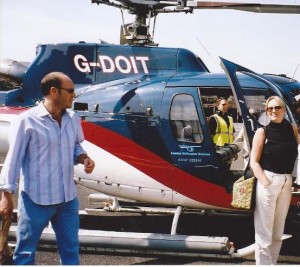
2004..somewhere in England…
“I hate flying. Know why? Because no one really understands how planes actually work.” Adam Levine.
I used to love flying. From about the age of 10 until I was about 45, I’d hop on anything, I didn’t care. I could be on a big plane, small plane, private, commercial, helicopter or whatever and I don’t remember a lot of trauma doing any of it. In 1999, that all changed.
I was on one of those flights that no one should have been on. My friend Reba and I were heading to London, from Omaha, through Chicago. It was February, usually a pretty dicey month to fly, a blizzard had started and the plane was delayed for several hours. So, instead of just walking out of the airport and waiting for it all to pass, when they finally called the flight, I got on. It was one of the least intelligent decisions I’ve made in my 56 years. I’ll keep this simple. It was horrible. Coming close to Chicago, we hit what they call a “microburst”. Here’s what they say about flying into one of those…
“A microburst is a very localized column of sinking air, producing damaging divergent and straight line winds at the surface that are similar to, but distinguishable from tornadoes, which generally have convergent damage. There are two types of microbursts: wet microbursts and dry microbursts. They go through three stages in their life cycle: the downburst, outburst, and cushion stages. The scale and suddenness of a microburst makes it a great danger to aircraft due to the low-level wind shear caused by its gusts with several fatal crashes having been attributed to the phenomenon over the past several decades.”
I never actually read that until today. I wonder what the pilot was thinking and more than that, I wonder what I was thinking. We never made it to Chicago. We landed sort of sideways outside of Madison, Wisconsin, so relieved to land alive that we ended up in a hotel bar, drinking with a one armed Mount Everest climber and a Sherpa. I didn’t make that up, that’s what we did. You do weird things when you think it might be over for you.
Another series of events happened, including a seriously dodgy landing in an Aspen snowstorm, various thunderstorms, and the death of two people I knew well in separate small plane crashes over 18 months, and I’ve had the fear ever since. It’s a fear that’s become rather legendary among my family, friends, doctors, therapists, and colleagues, as it not only frustrates me, it frustrates the hell out of some of them. So, I’ve compiled a list of some of the helpful hints ,comments, and treatment options they’ve given me over the years. Some of them don’t work that well for me, but some are kind of interesting. Here are a few..
1) The “Just Try Every Type of Therapy Invented” approach- If you can name it, I’ve tried it. Talk therapy, post trauma therapy, somatic therapy, EMDR therapy (that’s where you relive the trauma…works for some things, but..), group therapy, anti anxiety pills, hypnosis, biofeedback…are you tired of this yet? I was.
2) The “Henry Corra Drunk Dialing from Planes” method- my friend, film maker Henry Corra, flies a lot. He no longer drinks, but when he did, I’d get these calls on the air phones from him when he was full of Bourbon or some other brown liquid. He’d just drink and call people. Generally, there was the inevitable flight attendant interrupting to tell him to shut the hell up, but they were interesting calls. I thought about that, but I only drink when I’m happy, or if I’ve landed successfully after a bad flight. (see below).
3) The “Avoid Any News Story about Flying” method- I’ve tried that too, but it never works. Perhaps my fear draws me to stories, but I never fail to accidentally land on stories describing crazy passengers, crazier flight attendants, and even crazier pilot stories (drunk pilots, pilots having breakdowns mid flight). The new one is how the “sequester budget cuts” is going to take a big bite out of air traffic controllers. Holy shit…
4) The “Old Boyfriend Tough Love” suggestion- So, I was telling an old friend about my fear of an upcoming flight a few years back. He wrote me this beautiful story about fear and life and love and taking chances. It was so sweet I almost cried until I read the last line of the story… “Get on the f**#ing airplane”.
5) The “Driving Miss Cindy” way- This one was invented by two young friends, Courtney and Jeremy, who used to work for me. Yes, it has happened. I’ve chosen to ask some poor soul to drive me across the country a number of times. I remain eternally grateful to those poor souls….seriously, even when it was fun, it was a long way to go.
6) The “Lee Hirsch” method- This was one of my favorites. Since making “Bully”, Lee has logged more air hours than just about anyone, short of the former Secretary of State. He should check out her numbers, he might have more. He’d say, “I’ll fly to Sioux City and go with you.” Or “just take a Xanax”. “I have Lee”, I’ll tell him, “sometimes it doesn’t help”. His solution, “Take TWO!” He’s a trooper.
7) The Doctor One, Doctor Two, Doctor Three… action plans. The legions of nice doctors over the years have recommended everything from pills to doing it gradually-short flights, one at a time, to going to one of those airline “fear of flying classes.” That’s a fairly new suggestion. They actually have those, look it up.
8) The “Air Ted” and “Air Norm” or just simply “WaittAir” occasional option, only available for special occasions, which makes sense. My brother, “Dr.” Ted, put forth this theory, “It’s a control issue. You know that if you start to freak out, I can tell the pilot to land the plane”. He’s not only right, but one of my doctors actually agreed with him. Ted, go back to school, you have a future in this. These two options are my favorite air lines and not just because they spoil you (they do), but because I know how well maintained they are and I know who’s flying them. However, I still have trouble on some of those flights too. For instance, flying into Aspen (do not fly into Aspen, particularly in a snowstorm when you can’t see the airport). I think I owe them each probably about half a million dollars for flights, and I’m not worth that much, so I can’t pay them back.
9) The Affirmation method. Don’t you love it when someone actually gets what you are going through? Henry Corra again, “Cindy, it’s a completely rational fear. You are 30,000 miles up in a metal tube”. Yes.
10) My all time favorite from the doctor who has spent the most time with me, ‘THE JUST DON’T FLY” solution. He’s the one that always says, “why suffer?”. Love that guy.
Comments (6)
February 28th, 2013
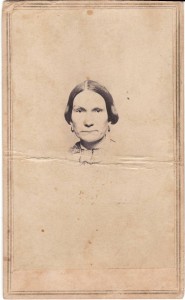
My great, great, great grand mother Lois Grant Holman, 1813-1856 This faded daguerreotype, most likely taken in the 1850’s is the only known image of her.
“Strange, isn’t it? Each man’s life touches so many other lives. When he isn’t around he leaves an awful hole, doesn’t he? “It’s a Wonderful Life”, 1946
“For most of history, Anonymous was a woman.” Virginia Woolf
Introduction
Her ancestors and relatives included a Mayflower passenger, a Governor of Connecticut, a signer of the Declaration of Independence, and a United States President. Three of her male descendants founded multi- national corporations. I found it easy to access information about the men that make up the the family tree of my great, great, great grandmother Lois Bulkely Grant Holman. Yet, like many women of her day, little seemed to be known about this woman who packed up with her husband and three children and came west to the bluffs of the Missouri River in Iowa from a comfortable life in Connecticut, in the spring of 1856.
The faded picture of her I finally ran across online, shows an eerie image of simply a face, rather plain, and looking somewhat sad and severe. A whole part of her is missing, like her story.
In adulthood, all I remembered about her from childhood stories told to me was that she was an early pioneer in our little part of the world, she was related to Ulysses Simpson Grant, and she was our connection to the “Sons and Daughters of the American Revolution”. More recently, though I’d recorded this years ago, I looked again at her death date , July 2 (in some records July 3), 1856. My date of birth is July 3, 1956. My favorite great grandfather, Holman Waitt, Lois’s grandson that she never knew, was also somewhat connected to this, being born July 2, 1886. Lois was also referred to in records as “Louisa” or “Louise”, my middle name, something my relatives never said to me, and most likely didn’t know.

With my great grandfather, Holman Waitt, Lois’s grandson, in the late 1950’s. He told stories of our history.
There was a symmetry to all of that and I decided to start digging. Stumbling across her rather interesting male antecedents was easy. But I wanted more. What I found was a piece of the story about the woman who made my existence possible. It came from her own hand, a letter written April 27th, 1856 from Sergeant Bluff, a small town south of Sioux City, named for 22 year old Kentucky native Sergeant Charles Floyd, the only man to die on the Lewis and Clark Exhibition. The location of the original letter is still to be determined and I have yet to track it down, but copies can be found in two or three museums. My first copy was given to me several years ago by Sioux City Museum curator Grace Linden. I would imagine its value for others lies in a rarely told story of pioneer life so early in this area, from the woman’s point of view. For me, it’s a priceless piece of my own family history, a history that is heavy with stories of men, but light on the stories of the women. That she died not two months after the letter was written made me want to know more.
Pilgrims, Pioneers, and Presidents
Lois Bulkely Grant was born in Rockville, Connecticut 200 years ago, on April 14th, 1813, to a family that was present and part of most of the key events in American history. As her fifth cousin, Civil War General and 18th President of the United States, Ulysses S. Grant stated in his memoirs, “My family is American, and has been for generations, in all its branches, direct and collateral.” Her fifth cousin was right.
Her mother, Electa Fuller was a direct descendant of Mayflower passenger Edward Fuller, a signer of the Mayflower Compact and his wife, Ann, who died the first winter of their arrival in the New World. Her father, Elisha Grant was the descendant of the immigrant, Matthew Grant, a co-founder of Windsor, Connecticut, who arrived at the colony of Massachusetts Bay on the “Mary and John” in 1630. Elisha also counted as his ancestors on his mother Lorana Strong Grant’s side a Governor of Connecticut, Roger Wolcott, and Oliver Wolcott, a signer of the Declaration of Independence.
The town of Rockville, where she grew up as Elisha and Electa’s fourth and youngest child, was founded by her great grandfather. Samuel Grant in 1726. By the time of Lois’s birth, the town was populated with the descendants of the children of her grandfather, Lexington Alarm minuteman and Revolutionary War veteran Ozias Grant, and her grandmother Lorana Strong, who gave birth to an astonishing 14 children. Elisha was the 10th of these children and is described as a builder and carpenter. Electa is described only by her family tree and her death, at 37, when Lois was four years old. The Grants, were part of the fabric of the little town, as owners of the woolen mill, landowners, soldiers, farmers, and deacons of the church. Her uncle Elnathan is described as the last survivor of the Revolutionary War in Tolland County.
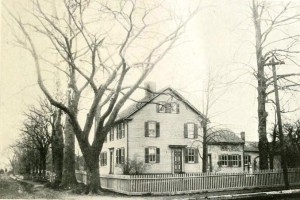
Homestead of Lois’s grandfather, Ozias Grant
Marriage and Family

Her husband, William Palmer Holman, date unknown, most likely taken years after the death of Lois.
There is no further information on Lois until she married my great, great, great grandfather, William Palmer Holman in 1837. Palmer, as she later calls him in her letter, from an old Connecticut family, apparently moved with his father to Salisbury, Vermont where he was in the business of manufacturing shoes for ten years, then returned to Connecticut, where their five children were born. Records generally show three children, but a further search told me that two of her five children did not survive childhood, not an uncommon occurrence in those days. Lois became the mother of Charles Jerome, born 1840; Albert Murillo, born 1845, Daniel born in 1848 and died young, Ella, born 1851 and one other child who died who also died young, referred to by her son Albert, but never by name. What possessed this family to leave their familiar and most likely fairly comfortable roots in the East and head to the wilderness of western Iowa is not known.
Going west

George Catlin, 1932, Oil painting done a few miles south of Sioux City.
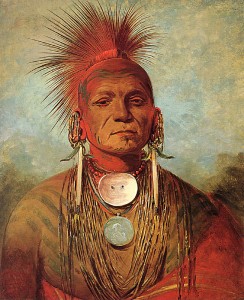
See-Non-Ty-A, an Iowa medicine man. George Catlin, oil. 1844-45
What is known is that Palmer came first, in 1855, traveling by rail to Illinois, to Independence, Iowa by stage coach, and to northwest Iowa with horse and wagon. A man named Bronson, a carpenter, accompanied him. The few settlers there, in what was called Sergeant Bluff City, seven miles south of the newly formed Sioux City, offered to build Holman a hotel and give him land, if he would return and manage it. The 1891 book “History of the counties of Woodbury and Plymouth, Iowa” recalled, “During the years 1854 and 1855 came William P. Holman, Leonard Bates, Gibson Bates, T. Ellwood Clark, William H. James, and a few others.”
When Palmer made the decision to return, Bronson remained there and built the small hotel and Palmer went back to Connecticut to “sell out”, as it was stated, and to bring along Lois and the three children. I like to think that a family conference was held, as it might be now between husband and wife, but my guess is that it being 1856, there was not much talk, and it was “whither thou goest, I shall go.”, and go she did.
Her son Albert, who later became a journalist and writer tells the story of their journey in his 1924 book, “Pioneering in the Northwest” :
“Mr. Holman sold out in Connecticut, and early in February, 1856, started shipping goods (and the other four Holmans) by rail to Iowa City, just completed. It took the train a whole afternoon to go from (Davenport to Iowa City) that 50 miles. The Holman Boys, when they got tired of riding, would jump off the train and run along behind the engine. Mr. Holman had bought a wagon and a team of horses in Chicago and shipped them to Iowa City. He bought four yoke of oxen in Iowa City, and they started for Sergeant Bluff. Three hired men and their three children and one adopted daughter made up the party. The children were C.J. Holman, aged sixteen, A. M. Holman, aged eleven, and their daughter Ella, aged six. The journey consumed 23 days. It took nine days to get from Council Bluffs to Sioux City”.
At the Little Sioux River, the rope ferry washed out and they joined forces with Charles Larpenteur, who kept the ferry…They cut dry cottonwood logs, made a raft, and with a new rope managed to get ferried over. W.P. Holman drew up to the hotel in Sergeant Bluff in April of 1856. The building was 18×24 feet, fourteen feet high, a story and a half. It was crudely built of cottonwood lumber sawed from th nearby woods, boarded up and down with cracks battened with strips, and shingled with long thick shingles…The second floor was reached by a ladder, and this floor was called “Texas” by the Holman boys. The boys beds were here and also a place for “guests” who were only men. It seems their idea of a hotel consisted of a ladder and a floor. He continues, “The first winter the snow had to be swept from beds before the guests and the boys could sleep.”
I try to imagine a woman later described by her granddaughter, who never knew her, as a “woman of gentle birth and delicate physique”, enduring this trip, this 18 x 24 foot “hotel” as a home, far from her roots. The letter provides some clues. This typed version, done in 1940 and just given to me recently by the Sergeant Bluff museum gave me a little more information about her death and solved the mystery of where the original letter was kept for many years. It was a home I visited many times, the home of my great grandparents. I may have seen it myself. This version of the letter reflects the original story told in the Sioux City Journal May 14, 1929.Some of the grammar and sentence structure had been modernized in this version, and the original they were working from was difficult to read.
The letter, written two months before her death:
Sergeant Bluff City, April 27
Dear Mother, Brother, and Sister,
As I have just received a letter from you with the greatest pleasure I thought I would answer it. I began to think you had forgotten us, but I know it takes a great while for a letter to go through. I wrote a letter to Alden’s (brother in law) father since I got here so I shall not write the particulars of our journey out here.
We are all well and keeping house after a fashion, but have not as yet very much to do with. Palmer has been down to the bluffs after one load. We have a bedstead and seven chairs and a good big stove. You would laugh to come in and see how we live. The boys have to sleep on the floor. We have no pantry or cupboard and we have to use trunks for a pantry.
We are going to have more room as soon as they can get up a log kitchen, bedroom, and pantry. We have a joiner working here now. He shingled the house we live in this last week. After he got the board roof off to commence to shingle, it began to rain and such a time we had you never did see. It made me homesick you had better believe.
We have a log barn built and the stages have begun to stop here. They go up to Sioux City one day and down the next, and when they come, they take breakfast here. There is a good deal of travel by here and we could have the house full every night but have no way to accommodate them yet. The place is building up faster over in Nebraska than it is here, and it is said it’s the handsomest country by far. Palmer went over last week and secured his claim. He can get a thousand dollars for it but he will not sell. They say the grass is almost big enough to mow over there.
Our boys commenced plowing last Monday with three teams. They plowed around a small garden patch of a hundred and sixty acres the first day! It is two miles from home. They have built a small shanty down there and will have to stay down there all the time while the weather is pleasant until after planting. They will have great times, I expect. It is a great country out here and is very pleasant. I wish you could be here and go up on the bluffs. They are close by here. Lucy (adopted daughter?) and I went up one day and it made my head swim. We could look over to Nebraska and see for miles around us the prairie as level as the house floor.
Jerome (son) has just got home. He has been forty miles after some of our goods and to get some potatoes and meat. He has been gone five days. He saw a snake curled up by the side of the road and jumped out and stepped on the head. The snake began to rattle his tail but Jerome killed it and brought the rattles home. It had four. I scolded him, but he said it was no different to kill a rattle snake than any other. We have not seen more than two or three deers, but there are wild geese by the hundreds. And ducks worlds of them but there is none here now.
We have meetings here once a fortnight. One sermon is preached in a store by a Methodist minister who is quite a learned man. He called on us yesterday and took tea with us. All the ladies that live here have called on me, the whole of six. I have not returned the calls but must begin soon or I won’t get around this summer. There are plenty of men here, however. They cast sheep’s eyes at Lib and Lucy’s girl but none has popped the question yet. I expect to hear any time that they have though.
The children are all contented but Ella says when she goes down to see Grandma, she shall stay there. She goes on a double trot over to Lucy’s which is close by and back again. As for myself, I like it here just about as I thought it would. If I had the same conveniences that I had back east and my friends were all here I could be contented, but I have some melancholy hours and a few crying spells does me some good.
I think of you and want to see you all, but when i think of the distance between us my heart sinks within me. Gardner, (half brother), I wish you could come out here and see the country and some of the rest of our friends. Give my love to all and receive a share yourself. I will leave the rest for Albert. Palmer wants you to send a paper once in a while. He will write the next time. Write again soon and write all the news you can think of.
Your affectionate daughter and sister, L. Holman
Following are postscripts from her sons, 11 year old Albert and 16 year old Charles Jerome,
Dear Grandmother, Uncle, and Aunt,
As mother has been writing to you, I thought I would write a few lines too. I can’t find much to write but I will try to see what I can do. I like the country first rate. I have been up to Sioux City once and when I went, Jerome and I and another man went up to Floyd’s grave. He has been buried there 52 years. I have to drive a team this week. We have five yoke of oxen where we are plowing. It is about four miles down there. We have built a log house and we will stay there while we work the field. Mother has to get supper and I have to get out of the way, so goodby, from Albert Holman
Dear grandmother,
As mother has written you I will put in a few lines. Mother has written most of the news. I like the country very well. It looks about as I thought it did. I have just got home from down the river and am going to start back for Council Bluffs (90 miles) tomorrow which will take me about 10 days. Give my love to Alden and Statira (uncle and aunt) and tell them that I will write when I get back. I killed a rattle snake today. I will send the rattles to you. (This young man is determined to have somone see these rattles).
Two sources helped me close the gap between the April 27th letter and her death July 2nd. The 1929 Journal story states that according to her sons, even at the time she wrote, “she knew that she was the victim of a dread malady and that her chances of recovery were very small. She kept her secret until failing strength gave it away. The father in desperation sent an appeal to General Harney, who was in a camp across the Big Sioux, and Mr. Holman thought there would be a good surgeon with the troops…In spite of all that could be done, however, in less than two months after the letter was written, Lois Holman died.”This brief description by her grand daughter Abigail in 1933 on the death of her own father, Albert, She says, in part…“ The hard trip and lack of comforts proved too severe for the mother, a woman of gentle birth and delicate physique. She lived only a few months after their arrival on the frontier. Mr. Holman had sent to Ft. Randall in South Dakota for the army doctor to assist Dr. William Smith of Sioux City. Lois Butler Grant Holman was buried in the hills east of the town of Sergeant Bluff in July, 1856, one of the first burials among the settlers in this vast and lonely region. Later her remains were removed to the present Sergeant Bluffs cemetery, which her husband was instrumental in having established as a township cemetery.” What the “dread malady” was I may never know.
What came after
William Palmer Holman remarried Caroline Mattison of Wisconsin sometime in 1857. She was described as kindly and refined, and gave birth to two more Holman sons, Milton Palmer and Edward Henry. She was also listed as the first school teacher in the area. Palmer continued to farm, raise cattle and founded WM Holman and Sons. Charles Jerome joined his father in farming and in the brick business then called W.P. Holman and sons. Albert, became a journalist and writer and eventually joined the family business as well.
Charles Jerome, referred to as CJ. married Meda Euseba Cole, who died young and had one child. He and his second wife, Kittie Carpenter had five children. He died in 1925, at 85. Albert married Emma Eliza Webster and died at 88 in 1933. They had five daughters and a son.
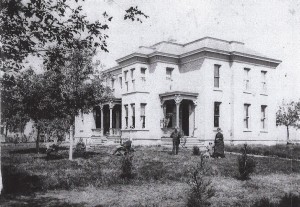
William Palmer Holman and family in a home built in 1876, 20 years after Lois’s death.
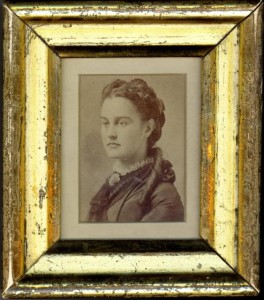
Kittie Carpenter Holman, wife of son C.J.
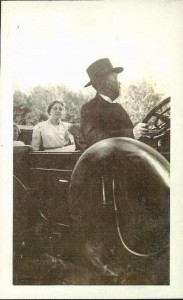
Granddaughter in law Dora Currier Holman and son Albert Holman
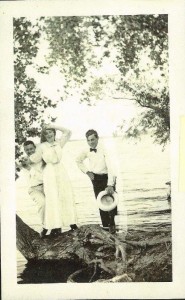
Lois’s grandson Clarence, left with his wife Dora, and with grandson in law Dr. Harry Schott.
Both of Lois’s sons were present at the reburial of Lewis and Clark’s Sergeant Charles Floyd, a grave they had seen as children more than 40 years before this photo was taken.
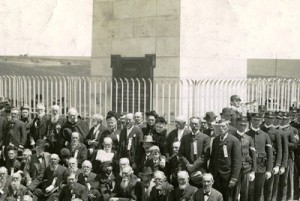
August 29, 1895, the reburial of Sergeant Charles Floyd, taken by photographer P.C. Waltermire
Lois’s youngest child, little Ella who would have rather stayed in Connecticut, stayed in Iowa and married my great, great, great Grandfather, Sioux City Stockyards pioneer George W. Waitt. Ella. a tiny woman like her mother, gave birth to 11 children, including my beloved great grandfather, Holman.
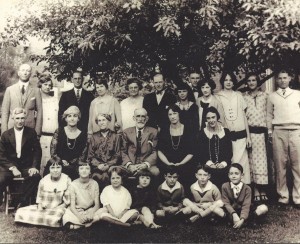
Ella Holman Waitt, her husband George W. Waitt, her children and some grandchildren, Sioux City, Iowa 1925. My great grandparents Holman and Hazel Waitt are back row, third and fourth from left. My grandfather Theodore Waitt was is back row far right.

Lois’s grandson Bert Waitt and son in law George W. Waitt, Sioux City Stockyards office, date unknown.
The descendants of the 22 grandchildren of Lois B. Grant Holman are spread far and wide across the country, as is my branch of the family, after being here for six generations. Only a few of us remain in the area, but the ties are still strong.
I visited Lois one cold day two months ago in a cemetery once called “The Holman Cemetery” south of town. She is on one side of her husband, William Palmer. On the other, his second wife Caroline.

To the side of this, though, her original grave stone from 1856. Like Sergeant Floyd, she was moved to a re-burial site late in the 19th century. His sandstone obelisk monument stands 100 feet tall and greets visitors to this northwest Iowa river city. You can’t miss it on the way in. Lois’ monument is tucked away in the Loess Hills, small and barely readable. I’ll be going back this spring, to take flowers, and to thank her for all she did for all of us.

First gravestone.
With gratitude to Grace Linden and Steve Hansen of the Sioux City Museum, to the family of Grant Holman and to Jerry Logemann and the Sergeant Bluff museum.
Comments (4)
February 21st, 2013

Willie Mays, Sergio Martinez, and Joe Torre on April 12, 2012 at a gathering of national leaders in violence prevention called “The Y Factor-Men Leading by Example”. Futures without Violence’s International Center to End Violence. Photo by Joseph Driste courtesy of Futures without Violence
“There are a lot of good guys out there, who are dying for the opportunity to do something, because, after all, it’s their mothers, sisters, daughters, and friends who are being victimized” Municipal Court Judge Ron Adrine
Almost fifteen years ago, the Waitt Foundation and Futures Without Violence went looking for a few good men and…we found them. And then, they found us. What we learned was what we already knew. There weren’t a few…there were many. This is just a piece of the story of our involvement with the men who made the decision to stand with women, and use their voices, their power, their positions, and their resources to make a difference in preventing violence against women and girls. Standing on the shoulders of women leaders, and like those women, they HAVE made a difference.
It started for us in the late 1990’s. A former colleague and domestic violence activist, Judy Stafford, approached me with an idea. She asked us to think about new partners in domestic violence prevention-men. It wasn’t completely new. There were men already out there doing the work, such as Mentors in Violence Prevention founder Jackson Katz, Men’s Resource’s Center founder Steven Botkin, former Philadelphia Eagles player Don McPherson, NOMAS, and the venerable White Ribbon Campaign in Canada. They were connecting with others and starting to speak up and speak out, working collaboratively with the women who were pioneers in the anti- battering movement in America and elsewhere. But, as Judy saw it, the budding movement needed some help from men from outside the movement, men in politics, media, sports, and business. She asked us, and more specifically, asked my brother Ted to not only consider putting the Waitt Foundation’s considerable funds behind the idea, but his voice as well.
He did consider it, and he acted. His green light took us to our crucial first contact with Esta Soler at Futures Without Violence, then the Family Violence Prevention Fund. Esta, already a national leader in the field of violence prevention, is a woman who gets things done, and those things tend to be big. Her advice? If we wanted men in the movement, we’d have to ask them not only “if” they’d do it, but “how” they’d do it. We asked and they told us. Our 2000 Peter D. Hart Research national poll said that they would get involved, they just hadn’t been asked. The “how” was that they were willing to talk to boys. Out of that research came a multi-year Advertising Council campaign that ran from 2002-2006 that asked men across the country to be role models and mentors to boys coming of age. It hadn’t been done before and it began to move needles. From a baseline study in 2001, we learned that only 29% of men had talked to boys about the issue of relationship violence. By 2007, that number had increased to 55%.

“Awaiting Instructions” campaign, part of Future’s without Violence multi- year marketing campaign with the Ad Council
During the same time period Ted became the first chairman of what is called “The Founding Fathers”, a group of men from all walks of life committed to public action and public statements about ending violence against women and girls. He and other men made phone calls to men in leadership positions across the country to not only lend their voice, but give their resources to this issue. On Father’s Day 2003, 350 men joined in an historic public statement to call for an end to violence against women and children. Their pledge along with signatures of all those men, appeared as a full-page ad in the New York Times.Over the next few years, many of those men joined activists and policy leaders at events in New York and Washington D.C., working with women and men who were “in the trenches” in any way they could.
One of those ways to get into the trenches was to gather a group of activists and sports figures, such as former Boston Celtics player and coach M. L. Carr, to create an on ground program that Futures Without Violence, the leader of this effort, called “Coaching Boys into Men”. Again, when men were asked how to help, they, along with the women who are always at the table, came up with something tangible. In this case, the program that was developed used the influence of coaches to talk to young male athletes about respect for girls and women. The program premiered in 2005 and was introduced in all 50 states and 23 countries. It’s still growing.
We began to see a sea change in the sheer numbers of men coming to the table to help. Baseball legend Joe Torre’s mother suffered horrific abuse at the hands of her husband, and prompted Joe to start his own foundation called “Safe At Home”. He remains one of our strongest allies. Mark Wynn, a former police lieutenant, tells the story of being the stepson of a man he calls ” a criminal”, who beat his mother before the time there were laws on the books. Mark now devotes his life to speaking to future law enforcement professionals and others in hopes that they’ll begin to understand the dynamics of domestic violence. People touched by what Gloria Steinem calls “original violence” are in your town and in your neighborhood and many of them are men like the man I had lunch with today, a former politician, whose mother was brutally murdered by a stepfather when he was in the 5th grade. Joining those men who may have acted to prevent the violence they personally witnessed were other men, like my brother and so many others, who may not have been touched by family violence, but could see how vital curbing this violence is to the future of our country and to our world.
We can see the traction in this movement against violence and see where it’s making a difference. Men’s groups such as Men Can Stop Rape, A Call to Men, and Men Stopping Violence began to grow and expand. Jackson Katz, Michael Kimmel, Byron Hurt, Tom Keith, Joe Ehrmann and others were writing books, making films, and speaking to college campuses about the importance of engaging men and boys. The Global MenEngage Alliance has more than 300 non governmental organizations worldwide. A CDC-funded evaluation of Futures’ “Coaching Boys into Men” found that athletes who participated were significantly more likely to report intentions to intervene when witnessing abusive or disrespectful behaviors among their peers than those not in the program. “Mentors in Violence Prevention”, a peer to peer in- school bystander program we have partnered with for 13 years, shows promise in improving school culture – with a significant decrease in the percent of students perpetrating one or more bullying behaviors in schools where MVP has been implemented. Those are just two of the programs now doing the crucial work educating young people. “Engaging Men” as allies in educating young men and women is now a strategy recognized by the State Department, the Department of Justice, the Clinton Global Initiative, the World Health Organization, and the White House.
The story doesn’t end there. There are many battles still raging on the front lines. Though progress is being made and domestic violence has decreased, the numbers are still staggering. Women suffer two million injuries from intimate partner violence each year, and an estimated seven million children live in families in which severe partner violence occurred. Despite this, vital funds and services to victims in my own home state of Iowa, as in many others, are being cut.
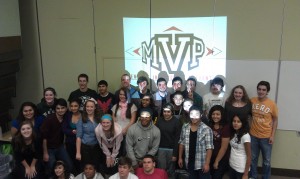
The future. Kids on the ground as part of Mentors in Violence Prevention in Sioux City, Iowa 2012 Photo by Dr. Alan Heisterkamp courtesy of the Waitt Institute for Violence Prevention
It takes time to change social norms that accept violence as a part of life. Women have been working on the issue of family violence for over a century. Men as allies are new to this movement, but as women are half of humanity, so are men. The majority of men don’t batter, but some of them like Joe Torre and Mark Wynn have been witnesses to assaults on their sisters, daughters, mothers, colleagues, and friends. Every man can do something to help and do it in concrete ways. They can give to vital protection programs for women and children such as local shelters, they can speak to policy leaders in their town and in their state, they can donate time and resources to school education programs, and like the men I’ve talked about, they can speak up, speak out, and most importantly, pass the message on to future generations. While the few who began to act have now become the many, we hope that someday soon, there will be many more.
Comments (0)
February 14th, 2013

The original poster.
May 6, 2009
From: alan@waittinstitute.org
To: cindy@waittinstitute.org
Subject: The Bully Project
From that first e-mail nearly four years ago introducing me to what became Lee Hirsch and Cynthia Lowen’s documentary “Bully”, I’ve only sobbed twice. I’ve cried at screenings, cried a time or two when things got frustrating with the process, and cried a bit when my part was finished. But two times, I had those gut wrenching “tear fests” that not only shake your body, but shake your soul along with it. You tend to remember those.
The first time it happened was in La Jolla, California in December of 2009. It was the night before the year-end board meeting of the Waitt Foundation and the Waitt Institute for Violence Prevention. Along with updates on many of our long standing projects, I was presenting a new one. It was called “The Bully Project”, a film about child-to-child bullying. I didn’t have much that was solid. I had a preliminary budget, one of those “shot in the dark” estimates that change during production and post production. I had Lee Hirsch and Cynthia Lowen’s vision and their passion, but they wouldn’t be in the room. I needed something brief and powerful, something that would demonstrate the urgent need for this project.
Lee sent it to me that night. In Lee fashion, he might come right down to the wire, but what he sends is almost always brilliant. What he sent that night was breathtaking. It was a three minute clip of footage he’d gathered from the family of Tyler Long, the 17 year old boy from Georgia, who took his own life less than two months before. Among home made film clips the family supplied of Tyler’s short life, was his father David’s running commentary about the torment Tyler experienced and the heartbreak the family was going through. It was real, it was raw, and it hit me where it hurt the most, as a parent. I think that night I moved from a passionate supporter of an important issue to a mother with a mission.
The meeting the next day was early, and I was first of a long line of presenters that day. I had just wrapped up the yearly summary. Time was running short, but I had one more thing to present to the group, which that day included our investment advisers, attorney, accountants, management staff, and the members of the board. I’ve learned that when you present to this group, it’s a good idea to be clear, concise, and have your numbers in order…particularly the numbers. Most of these people have a business background. I don’t, I’m a social worker. A glance at the clock told me I had about 3 minutes left.
I showed the clip. When it was done, there was a silence, not necessarily a good thing when you’re showing film clips, but I’d had been watching the group intently. The reactions ranged from actual tears to that kind of uncomfortable shifting in the seat that people do when they’re trying not to cry. I hadn’t shown them the budget, the time projections of production and post production, or the ideas that were already forming with a social action campaign. Ted just said to me, “How much do you need?”
The film was the perfect meshing of the right time, right place, right issue as well as the skill and passion of the film makers. But it was more. For me at least that day, in that room, it was watching those people, probably 90%of them parents, reacting as humans caring about their young.
We weren’t the only supporters of the film, we just came in early, as did the brave and forward thinking Sioux City Community School District. We had partners show up, first a few, then.. the many. The next year brought The BeCause Foundation, The Einhorn Family Charitable Trust, and The Fledgling Fund. After that others joined in, and not just the large foundations. There were hundreds, if not thousands of supporters, who knew this film should get finished and get out there to kids, parents, and educators. The film’s purchase in April of 2011 by the powerful and influential Weinstein Company then took us places we never thought we’d go. Harvey Weinstein didn’t have to get behind the film, but he did, and as Lee said, everything he promised came true.
The second time I broke down? It the night in January that Lee and Cynthia accepted the “Stanley Kramer Award” given each year by the Producers Guild of America. I couldn’t be there that night , but Lee kept me posted. In a text message, he sent me this:
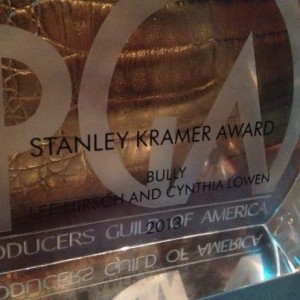
It brought on the tears, again. I think that was because I thought that really none of us is alone in this sometimes harsh and uncomfortable world. We do our best work when we do it together. It not only took a village to raise this “child”, it took a nation. Every one who wrote a check, a news story, a tweet, a petition, or a comment in support, and who helped “raise” the film and the project played a role. As David Long says, “Everything starts with one and builds up”. To the “ones” who became the many, thank you.
Comments (0)
January 26th, 2013
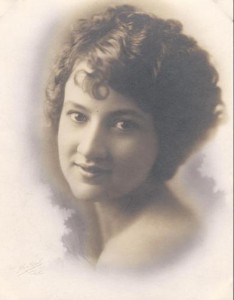
Mildred Emma Armstead, our grandmother, 1904-1990. We called her “Momo”
“Taught from their infancy that beauty is woman’s scepter, the mind shapes itself to the body, and roaming around its guilt cage, only seeks to adorn its prison.”
I do not wish them to have power over men; but power over themselves.” Mary Wollenstonecraft
My maternal grandmother’s portrait is in the lobby of the Orpheum theater in Sioux City, Iowa. It’s a former vaudeville and movie palace built in her heyday, in 1927, lovingly re- imagined and restored by the people of the city, with help from my two brothers. That’s why her picture hangs there. I often see people stop and stare at her. They comment to me often on her curly black haired, unusual, and sultry beauty. She had that particular 1920’s silent movie star or Zelda Fitgerald style, an angelic look that you figured hid a devilish sense of fun and mischief. She was fun and she was mischievous, so we named a piano bar after her, in the same building.
She was born in the heartland, and in a time and in circumstances when women were discouraged from looking inside, and prompted to find success in the beauty of their homes, their clothes, their children, and their lifestyles. At those things, she succeeded and succeeded as she was expected to …beautifully. Her luck with men, as many as she gathered, and there were many, wasn’t as good. Had she been born 50 years later, her life could have looked very different.
She had three husbands, in the days before women had three husbands. Two of the divorces weren’t her idea, one was, and that decision was a smart one. Her many married names gave rise to my often told joke that my own many married names made me sound like a law firm.
“ Were woman to ‘unsex’ themselves by claiming equality with men, they would become the most hateful, heathen and disgusting of beings and would surely perish without male protection.” Queen Victoria
She was raised by Victorians, was a child in Edwardian times, but came of age in the 1920’s. All of those times defined her. Her own name, before she add so many names to it, at birth in 1904 in Winchester, Kansas, was Mildred Emma Armstead, It was before the first world war that changed so much, before women could vote and in a time when it was said by her mother that ” a lady is only in the newspaper three times in her life…when she was born, when she was married, and when she died”. She broke that rule early on and most likely would have continued that if she’d had that chance. She was the first and only child of Minnie Louise Griffith and Dr. John B. Armstead, both of English descent whose families were early Kansas pioneers. Their home is a stately Victorian, that remind me of Amelia Earhart’s childhood home, not 20 miles away.
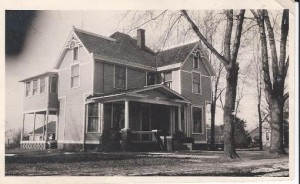
What she calls “My old home”, Winchester, Kansas.
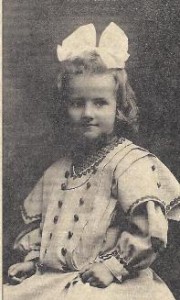
“Momo” about 1910

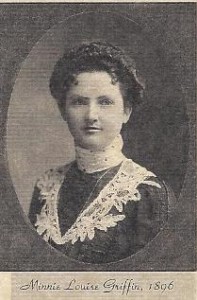
Dr. Armstead, who would travel on horseback to tend to patients in Jefferson County, suffered a fall at 37 that led to a brain tumor. He was buried on Mildred’s 10th birthday. Minnie did remarry, but was widowed twice more. Grandma, however, told me she had a good childhood and she had a kind and good- hearted mother who ” I’m afraid spoiled me a bit.” I suspect she spoiled her a lot. She also had an indulgent step father and a widowed grandfather who adored her. I can see from the old pictures she didn’t want for much, driving a swanky car in her teens, and always dressed exactly the way she was supposed to be dressed in that time. She was the first woman in her family to graduate from college in 1926 at Baker University in Baldwin, Kansas. It was there she met my grandfather William Gaston, a handsome, charismatic man with a beautiful singing voice . But before that, she was as they used to say “a belle”, and being that belle was a big deal.
“She tried to weave the strength of her father and the young beauty of her first love, the happy oblivion of her teens and her warm protected childhood into a magic cloak.” Zelda Fitgerald “Collected Writings”
A pretty child who grew into her beauty early and blessed with obvious charm and style, “Momo” never lacked for attention or for “suitors”, as she called them.
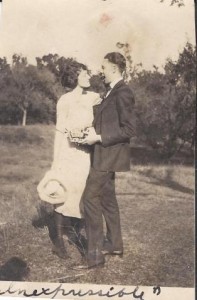
So, that’s where I get my old flirting tendencies…who is this guy?

Looks like the same guy, before she met Grandpa. I’ve found more of these, but the faces on the adoring men change…
I look through her old clippings, some faded to the point of being unreadable, and glean what I can about the details. Momo herself and my own mother Joan, her only child, have filled in the rest. The yellowing scrapbooks she saved gives credence to the years of stories of her little brush of fame in the days when women had just started bobbing their hair, sipping gin, driving cars, speaking out, and delightedly shocking their elders. Ironically, the college she attended didn’t allow sipping gin, or much of anything else. Dancing and card playing were also verboten. She must have found the time and place to indulge in a bit of wicked fun, although she may have followed the rules that made her want to break out of that box later. I like to think of her as a big time shocker to her adoring but strict Methodist family. Beyond that, though, according to her, a young lady’s popularity, style, and charm was the key to success and the eventual goal was to catch the right man. Gathering titles as a college beauty queen didn’t hurt. She did that, and apparently did it quite well. Her favorite story was about spring of 1926, where she was crowned, “Queen of the May” at her school.
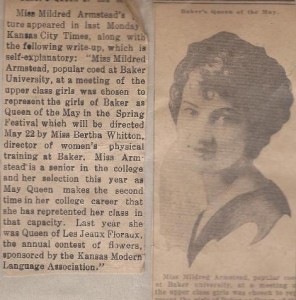
1926, Kansas City Times
According to this story, she’d had another beauty queen round the year before, as the “Queen of Les Jeaux Floraux”. That story calls her “The Queen of Beauty”. What followed theses queenly titles was the story she told the rest of her life and the story that always made me a little sad. She went to summer school one year at UC Berkeley in San Francisco, and a talent scout for Cecil B. DeMille noticed her. Contact was made to her family from De Mille’s office inquiring about the future of their daughter. Her straight laced mother and step father apparently found an acting career at that time way too scandalous, and that was the end of that. She returned to Baker. She may have felt sad then too, but I doubt too sad. She was on the track she set out for herself, or was set out for her, and my guess is that she was too damned happy to be so wanted to cry much over not becoming the next Gloria Swanson.

In California, on the trip where DeMille’s scout noticed her. No wonder, she looks so radiant here.
As much as she adored men (there are many pictures of her with men who weren’t my grandfather), she also surrounded herself with like minded women. She was the quintessential sorority girl, with a dance card. I actually found one. It was full. Her Zeta Tau Alpha girls were a big chunk of her life back then. When I didn’t pledge in the 70’s, she was dismayed and pronounced that she had serious doubts that I’d find the right type of man to marry. As hard as I’m sure she studied in Home Economics, her major, she never spoke of the academic side of college too much, at least not to me. An essay she did on Shelley and Keats is saved in a blue book, and is marked with a resounding “F”. She may have cried on that one, as she, like me, cried very easily.

The girls of Zeta Tau Delta, all with identical bobbed hair, Momo sixth from right, standing.
“Ev’ry morning, ev’ry evening
Ain’t we got fun?
Not much money, Oh, but honey
Ain’t we got fun?” Cole Porter
She did graduate, though, and she actually taught for a short time, until her impending marriage made her “unfit” to teach. As completely crazy as that sounds today, there were laws then in some states that barred married women from teaching. But marry she did in 1927, to the man who was to become the father of her first and only child, Joan Louise Gaston. Bill Gaston isn’t hard to describe. There wasn’t a microphone, a Scotch, or a woman he didn’t relish. He was smart, he was a story teller and singer, a great salesman who ended up as an international vice president of BF Goodrich company. He flirted with my bridesmaids, and he once left my pre- teen brother Norm and I in a park in 1967 in San Francisco, while he ducked into one of his favorite piano bars. Two children from Iowa had an early education into all things Haight Ashbury, and I’ve always thanked him for that. We loved our grandfather, but Bill Gaston was, as my mother said, ” somewhat of a “rounder”. She’s also used the old term “Roue” to describe her father. This telegram I found, sent to grandpa on the eve of their wedding gives a hint.

It says, ‘YOUR IMPENDING DOOM IS APPROACHING, NOT TOO LATE TO RECONSIDER, SIGNED, THE COMMITTEE. Grandpa forged ahead, although the marriage didn’t last.
They moved to St. Louis, where he was on the road, she swept her floors to the point of annoying her neighbor, and my mother thought that before she was born in 1931, “she must have gone mad with boredom”. It didn’t look like the glamorous duo missed any fun in the early days, however, and this picture speaks for itself.

As my brother Ted said, when I compared them to F. Scott and Zelda Fitzgerald, “They look more like Bonnie and Clyde :).”
I still like to think of them as Scott and Zelda, only not as drunk and self destructive. (Well, maybe drunk sometimes… :)) My charming grandfather pronounced to her one day that he would prefer the single life, a shock I don’t think she ever got over. She’s always pronounced him her true love, and though they didn’t see each other for years, they kept in touch later and then for the rest of their lives.
“It seemed that the only lover she had ever wanted was a lover in a dream.”
― F. Scott Fitzgerald, The Beautiful and Damned
Momo, as emotional as she was, was a pragmatist and she soldiered on selling Avon cosmetics until she ran into husband two, who was older and rich… really rich.. and founder of a company that exists today. She was his third wife. That was a long marriage, but from comments from my parents, a difficult one. He treated her to all that money could buy, furs, jewels, three homes, a suite at the Waldorf , but he didn’t always treat HER that well, according to reports. She was banned from any contact with my grandfather, as was my mother, a ban that didn’t lift until husband number two’s death in the early sixties. Mom tells that grandma “wore herself out trying to please him”, including putting my mother in boarding schools, as he wanted her to be free to travel. Momo did what she was told, to her later regret. But she always told me she married him for love, and I believe her. Being Momo though,she had to add, “You know Cindy, you should marry for love, but try to love where there’s money”. I think things became important to her early on, perhaps to replace the romantic lover that she could land but not keep completely, perhaps to make up for the early death of her father. I don’t really know, but she needed a sense of safety, beauty, and comfort and made sure she had them.
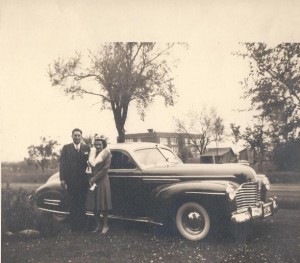
Momo and Husband Two in the 1940’s. The cars change, the husbands change, the furs stayed.
Husband Two, after 20 years, also announced he was moving in a new direction, another shock to her system. By then, she was in her mid 50’s and time was marching on. I would imagine she was frightened about her place in a society where everyone she knew was part of a couple. That’s how the world worked, and still does, in some ways, in the world of country clubs. It was particularly hard for women, she told me later, again advising me about the risks of divorce.
“In those days, we didn’t have a name for domestic violence, we just called it life” Gloria Steinem, in the upcoming documentary “Private Violence”
She still had the style and the charm and the ability to attract men, but again, not always the right ones. I understood that about her, as it took me years to get any of that right, and nothing in love is ever completely right. But she deserved more than what life brought her next. She met a man who came off as a quiet and proper person, almost “the demeanor of a preacher”, as my mother said, who hid what he was inside, a dangerous and violent alcoholic. He pushed her down one night, and injured her back. I only heard about it years later, when I was in my twenties. It may have happened once, maybe more. I never knew, she only admitted the one “incident”. Everyone kept it quiet. Violence like that wasn’t discussed anywhere, particularly in the country club set. It was hidden and as our next film calls it, it was “private” violence. It has a name now, given by Dr. Susan Weitzman after many years of research on what she calls “upscale violence” when she wrote the book Not to People like Us: Hidden Abuse in Upscale Marriages. That wasn’t available in the mid 1960’s. Nothing was. She did end that marriage, and moved on. There were a few other men, one old “beau” who lived in Florida, who she visited, who was a good man, but ill and that wasn’t in Momo’s plans. As smart as she was about so many things, my sense was that she never seemed to be able to feel completely appreciated by the men she knew.
“There’s no beauty without poignancy and there’s no poignancy without the feeling that it’s going, men, names, books, houses–bound for dust–mortal--” F Scott Fitzgerald, the Beautiful and the Damned”
I can picture her now as my plump, soft, silver haired grandmother with the feisty spirit and the sometimes sharp tongue, but I also like to go back into her history and freeze her in the early years of the past century and in the 1920’s, before the world taught her that love and life weren’t always easy and that beauty fades and with that, lives change. I’ve kept her there in the pictures for this story. I think she would have liked that.
I live in her home now, a home I spent so much time in as a child. I would visit often and have overnight stays here in the pale yellow guest room I loved. By then, she lived alone and loved the company, and would spoil all of her grandchildren with her famous southern fried chicken and delicious desserts. She had beautiful things and took pride in her sparkling clean home full of treasures amassed during her long life. She could tell you stories of each piece acquired from the Steinway upright piano to the prize winning chandelier she’d bought in New York. Her jewelry and furs were a treasure trove to a young girl who loved to play dress up. She would pull those out for special occasions. When you came to pick her up for those occasions, in her later years, she’d greet you at her door swathed in perfume, perfectly made up, and dressed impeccably. At 13, much to my mother’s horror, she took me to see “Sonny and Cher” live in Chicago, introducing their film “Chastity”. My first visit to Saks Fifth Avenue was with her. She was, I always thought, terribly glamorous.
She loved to travel, she still loved parties, men, her church, shopping, the theater, and music, and she had a genius for investing her money. My mother tells me she would outdo her financial advisers in picking the right stocks, something I’ve been told about my older brother, Norm. Perhaps he got that from her. Her finest investment made her a bit famous in the 80’s and 90’s in the heyday of Gateway computers as “Ted Waitt’s grandmother who loaned him a 15,000 CD”. (The loan became 10,000 from the bank, much to my brother’s dismay). The media called her “Momo” sometimes, in the stories. So did we. Money was still important to her. When she was assigned as our babysitter, she’d occasionally “disinherit” us, thinking that would be the worst punishment we could get, particularly as obnoxious teenagers. It didn’t stick. She’d open her door to any of us the next day, with a big hug and “well, come in, honey”. She was generous. Her favorite saying when you tried to buy something yourself was “Save your confederate money, dear, the South may rise again”. I hoped it didn’t. She loved her home, as many Cancerian girls do. She was a creature of habit, and when I would visit, in the early evenings, she would give you a bottle of Squirt and bowl of cocktail nuts, pour herself a Scotch and tell me stories, both of the highlights of her life, and the low points, something she wasn’t afraid to share.
She taught me to cook her famous fried chicken, to turn a bit in pictures to make yourself look slimmer, to play “Clair de Lune” on her prized piano, which I can no longer do. She taught me how to clean that gorgeous chandelier, and she also taught me survival. She lived into her late 80’s and braved some health problems before she died one Christmas season. I made many of the mistakes she made, particularly with men, and knowing that,I always tried to do things to lift her loneliness a little. Every New Year’s Eve, I would call her, from wherever I was, and wish her Happy New Year. I’m late this year, but wherever you are, Momo, Happy New Year. I hope your dance card is full, with something or someone you love and I hope it’s a place as beautiful as you.
Comments (8)

















































